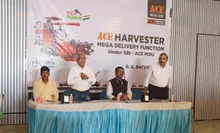
Ber Mealy bug (Perissopneumon tamarindus (Green) (Homoptera: Monophlebidae) are cottony and white in appearance, small oval, soft-bodied sucking insect pest. Adult mealy bugs are found on leaves, stems and roots and are covered with white mealy wax. They form colonies on stems and leaves developing into dense, waxy and white masses. They sucking large amount of sap from stems and leaves with the help of piercing/sucking mouth parts, depriving plants of essential nutrients.
Biology of mealy bug
The mature female lays eggs in an egg sac of white wax, usually in clusters on the twigs, branches, or bark of the host plant but sometimes on the plant’s leaves and terminal ends. Each egg sac may contain as many as 600 eggs, majority of which are female resulting in explosive outbreak. Eggs are minute, varying from 0.3 to 0.4 mm in length. Egg development takes between 3 and 9 days. Eggs hatch into crawlers and are very mobile. In appearance, nymphs of both sexes resemble female adults. There are three nymphal instars in female and four in males which lasts for 22–25 days. The last instar of the male is an inactive stage with wing buds within a cocoon of mealy wax. Individual mealy bugs may take as long as 30 days to grow through all the nymphal stages under normal conditions. There may be as many as 15 generations per year.

Mealy bug adult and crawlers
MODE OF TRANSMISSION
Non-infected plants can be infected from infected plants as juvenile mealy bugs can crawl from an infected plant to another plant. Small ‘crawlers’ are readily transported by wind, rain, birds, ants, clothing and vehicle and may settle in cracks and crevices, usually on new plants. The wax, which sticks to each egg, also facilitates passive transport by equipments, animals or people. As the infested plant back the colonies of mealy bugs migrate from shoot tips to twigs, branches and finally down the trunk. Ants, attracted by the honeydew, have been seen carrying mealy bugs from plant to plant.

NATURE OF DAMAGE
Infested growing points become stunted and swollen which may vary depending upon the susceptibility of each host species. Heavy clustering of mealy bugs can be seen under leaf surface giving the appearance of a thick mat with waxy secretion. They excrete copious amount of honey dew that attracts ants and help in development of black sooty mould which inhibits the plants ability to manufacture food. Both nymphs and adults suck the sap from leaves causing withering and yellowing of leaves. Fruit may drop prematurely when fruits are infested. The most predominant symptom is wilting of leaves, commencing from leaf tips.
ASSOCIATION OF ANTS AND MEALY BUGS
Mealy bugs are known to bribe ants with their sugary secretion (honeydew) and in return ants help in spreading of mealy bugs and provide protection from predator ladybird beetle, parasites and other natural enemies. Ants also keep their colony clean from detritus that accumulate in the secreted white, waxy coating of the mealy bug. Mealy bug infected fruits are unfit for marketing. Species of ants such as Crematogaster sp. have been found attending mealy bug, P. citri while feeding on honeydew on Hibiscus.

Management practices
Mealy bug control often involves the control of caretaking ants that are important for the proper development of mealy bugs. Without the ants, mealy bug populations are small and slow to invade new areas and the field would be free of a serious mealy bug infestation. Therefore, management of mealy bugs often includes the control of ant species.
For management of mealy bugs, it is important to know the species present as management programs for the various mealy bugs may differ. Plant protection products are of limited effectiveness against mealy bugs because of their habit of hiding in crevices and the presence of waxy covering of its body.
Cultural and mechanical Control
Physical barriers such as ant fences can be applied parallel to the field periphery to keep ants away from field, and subsequently help in controlling mealy bug populations. All crop residues in previously infested fields should be removed and burnt. Crop residues and grass left in the field may harbor mealy bug populations which may invade the new crop. Orchards border should be free from weeds and debris that may support mealy bugs. Weeds also provide alternative host for ant populations between periods where mealy bug infestations are small. Remove alternate host plants like Hibiscus, okra, custard apple, guava, etc. in and nearby crop. In case of perennial crop remove loose bark to expose hiding population of mealy bugs and swab stem and arms with dichlorvos 76 EC @ 2 ml + 2 g of fish oil resin soap in a litre of water. Apply sticky bands like ‘Track-trap’ or ‘Bird Tangle Foot’ on arms or on main stem to prevent crawlers of mealy bugs reaching the bunch.
Biological Control
Biological control is considered the most effective long-term solution to the mealy bug infestation because the parasites and predators are self perpetuating, persist even when the mealy bug is at low population densities, and they continue to attack the mealy bugs, keeping populations below economic injury levels. The coccinellid beetles such as Cheilomenes sexmaculata, Rodolia fumida, Scymnus coccivora and Nephus regularis are important predators of mealy bug nymphs. Biological control by release of natural enemies has proved very successful. Among the biological control agents introduction of Cryptolaemus montrouzieri, Anagyrus pseudococci and Chrysoperla sp. Foliar spray of Verticillium lecanii or Beauveria bassiana (2×108 cfu/ml) @ 5 g/ml per litre of water is effective during high humid months in reducing the population of mealy bugs.
Chemical Control
There are limited plant protection chemicals like Dimethoate 0.2 % or . Propenophos 2ml / lit and Neem oil 10ml/lit of water revices, and the waxy covering of its body. Most granular insecticides are ineffective; therefore, systemic insecticides are used to control heavy infestation . Locate ant colonies and destroy them with drenching of chlorpyriphos 20 EC @ 2.5 ml/l or apply 5% malathion dust @ 25 kg/ha as the ants provide them protection from parasitoids and predators and also helps in spreading the crawlers to non-infested plants.
References:
http://ipm.uconn.edu/documents/raw2/html/682.php?aid=682
https://www.plantmanagementnetwork.org/elements/view.aspx?ID=2890
Author:
Hanwant Kumar
Plant Pathology
Senior Research Fellow
Agriculture University, Jodhpur
E-mail ID: h_dewasi@yahoo.co.in
|
Co- authors: |
|
|
Dr. Chhiter Mal Ola Agri. Entomology Senior Research Fellow Agriculture University, Jodhpur olachhitermal@gmail.com |
Archana Karel Food & Nutrition Senior Research Fellow Agriculture University, Jodhpur |












